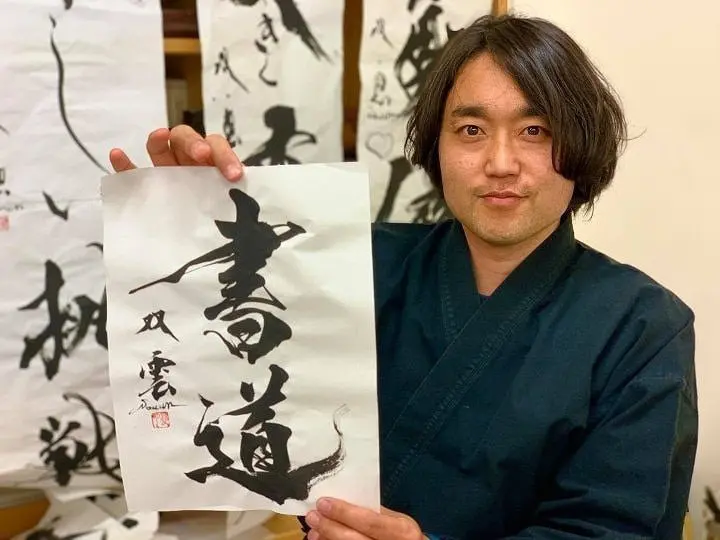Japanese Culture and a Joyful Heart: Becoming a Calligraphy Artist

Souun Takeda, a calligrapher and contemporary artist, introduces Japanese culture in a series of original essays. In this second installment, he shares an event that inspired him to follow the path of shodo, which is calligraphy or "the way of writing."
Souun Takeda: A Japanese Calligrapher and Contemporary Artist

Souun Takeda, a calligrapher and contemporary artist from Kumamoto, was born in 1975. After working as a company employee, he began his career as a calligrapher in 2001. He's even produced various title credits for TV programs and movies. Currently, he hosts calligraphy workshops and exhibitions all over the world.
In this series, Souun talks about the essence of Japanese culture through calligraphy. Click the link below to read the first installment:
Part 2: How I Decided to Become a Calligraphy Artist

Souun Takeda in his first days as a company employee, alongside his mother.
While working for a large company, I used to write memos to my colleagues using traditional brushes and Indian ink. Rumors spread, and I was soon asked to handwrite the company's mottos and even business letters to their clients.
One day, a colleague from the sales department asked me to write her name. She added that she would buy me lunch, so I happily obliged.
After seen her name written as calligraphy, tears began to fall from her eyes. She confessed, "I didn't like my name, but this calligraphy of yours changed that. I'm not on good terms with my parents and haven't talked to them for a while. But now I feel like giving them a call."
At that moment, I realized that tears were running down my cheeks as well. It was a feeling I had never experienced before. I never thought that my calligraphy would move others, but this is just what happened that day.
Like a lightning strike, a thought came to me. I was inspired to make an impression on others with my calligraphy, and help inspire them.

A scene from Souun's days as a company employee
I wrote a resignation letter on the spot, took it to my boss, and told him that I was resigning to follow my dream. He refused to accept my resignation and tried to talk me out of it. However, my mind was already made up.
Six months later, I resigned from the company. Until then, I worked hard to show my gratitude, which was reflected in my stellar business performance. I learned that things greatly improve when you try to make your company and its customers happy.

A scene from my days as a street performer.
Just before resigning, I met a street musician playing the saxophone at Yokohama Station while heading home from work. I found myself listening to his beautiful performance from start to finish. I then told him about my plans of starting a career as a calligrapher and asked for his advice.
He replied, "I'm playing at another station tomorrow, so why don't you come along? You can write something while I play."
I didn't know what to make of it, but I took the next day off from work. After arriving at the station where the saxophonist was going to play, I sat down about five meters away. He started playing without any fanfare, but the crowd slowly grew and was cheering him on.
Although I was extremely nervous, I took out my tools and began writing on a shikishi (paperboard).
Not a single person stopped in front of me. Thinking back now, this was inevitable. I just kept writing, so passersby likely had no clue what I was doing.
The first day ended with no audience. But on the second day, I improvised, and another miracle occurred.
Editor's Note

This calligraphy work by Souun Takeda consists of the word 決断, which means "decision" or "determination." Notice that even the strokes convey resolution and determination.
Born in 1975 in Kumamoto. After graduating from the Tokyo University of Science, we worked for NTT, then started his career as a calligrapher. He has produced various title cards for TV programs and movies, including TV series by NHK. In 2020, he held his first individual contemporary art exhibition. Currently, he holds calligraphy workshops and exhibitions all over the world.




























![[Coupon Available] Attention Overseas Winter Sports Fans! Nagano's Sports Depot Has Evolved](https://resources.matcha-jp.com/resize/720x2000/2026/01/05-254819.webp)
![[2 hours from Tokyo ] 10 Quiet and Breathtaking Views of Mount Fuji in Yamanashi Hokuto City , Yamanashi - Part 2](https://resources.matcha-jp.com/resize/720x2000/2025/12/16-253037.webp)

![[Reopening in March 2026] Ikoma Sanjo Amusement Park Park, 45 minutes from Osaka , with free admission](https://resources.matcha-jp.com/resize/720x2000/2024/08/28-194409.webp)